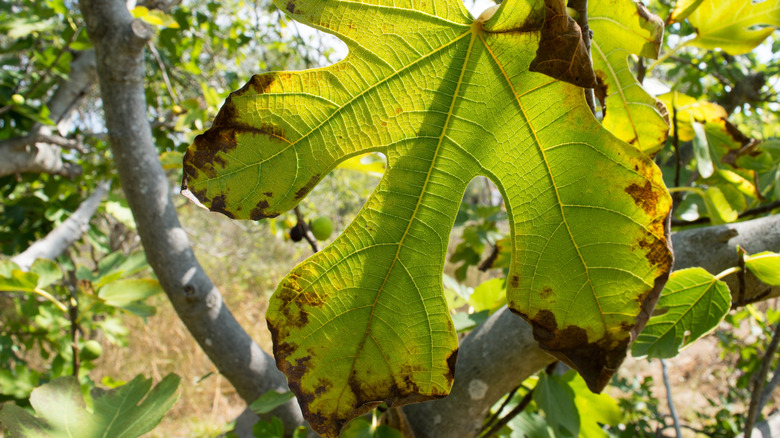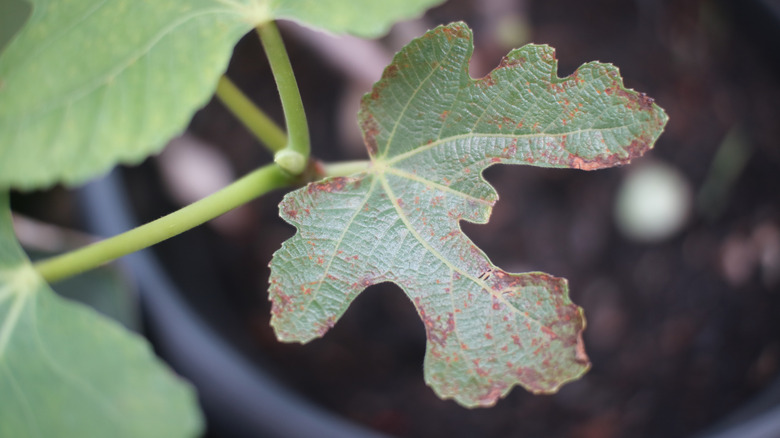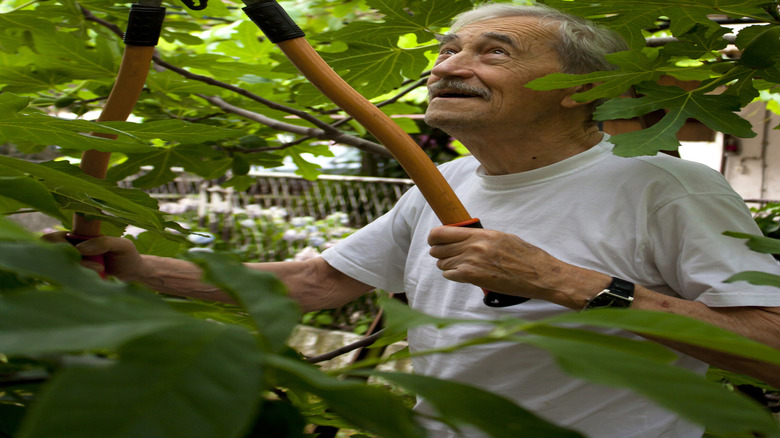Why Your Fig Tree Leaves Are Turning Brown (And How To Fix It)
Brown leaves on a tree can be a sign of many different problems. If your fig tree's (Ficus carica) leaves are turning brown, you might be anxious to take action and save your tree. But, depending on your location and the conditions in which your fig tree is growing, brown leaves could be a sign of too much moisture or not enough.
Too much moisture can increase the risk of root rot and fungal disease, both of which can cause browning. Meanwhile, a lack of moisture can cause leaves to wilt and dry out, turning brown in the process. To make sure you don't over-water when you should be watering less (or vice versa), monitor your tree for a few days. Different stressors and diseases can be easily confused in the early stages. However, noticing how the symptoms progress over time can usually give you a clue about which problem you're dealing with.
You can also factor in other observations to make the correct diagnosis. If it's the middle of summer, it's unlikely you're dealing with frost injury. If you just had a month of heavy rain, your tree probably isn't experiencing drought stress. If it's late in the season, browning may just be a sign the tree's leaves are dying off ahead of winter dormancy. Once you know what you're dealing with, you can make the changes needed to salvage the stressed trees in your yard. That might involve improving soil drainage and airflow, adjusting your watering habits, or removing diseased parts to stop the spread of an infection.
Tips for identifying the cause of browning fig leaves
While leaves can start turning brown for lots of different reasons, one of the most common diseases that result in browning fig leaves is root-knot nematode. These microscopic pests typically live in sandy soil and feed on tree roots. However, the damage might not be noticeable for years. If the brown leaves are on a tree that hasn't grown well for the past few years, it's worth having your soil tested for nematodes.
If the browning is caused by a fungal disease, it will usually appear as a series of spots all over the leaf, almost like a rash. Importantly, fungal diseases usually look different as they progress. In leaf spot, for example, the spots first appear reddish brown and elongated. As the spot grows, the center will start to turn, and the spot will often be surrounded by a yellowish halo. Leaf rust usually first appears as a cluster of small, yellow spots that darken and grow as the infection progresses.
If the browning leaves are dry or curling, it might be a sign that your fig tree isn't getting enough water. In the early stages, the leaves might wilt or droop during the day but firm up again in the evening. This is because leaves lose moisture faster than the plant can replenish it during the day. At night, moisture loss slows down, so the leaves are able to recover a bit.
How to treat your fig tree with browning leaves
For root-knot nematodes, there is currently no treatment to kill the pest, but proper tree care can prolong the life of your fig tree. You can reduce the damage nematodes cause by amending the soil with compost and mulching well. For a fungal disease, the first step is to prune the infected leaves, collect any dropped leaves to the ground, and toss them in the trash to reduce the risk of repeating or spreading the infection.
Next, address the excess moisture issue that likely allowed the disease to flourish. To correct poor drainage, amend the soil with compost. If you're overwatering, switch to a schedule of watering deeply but less often. If humidity is the issue, find ways to increase airflow. This might mean transplanting other shrubs or trees that are planted too close to your fig tree. You can also prune your garden's fig trees to create more space between branches.
For fig trees that aren't getting enough water, the best fix is to give them more water. However, you don't want to make a watering mistake that's sure to kill your precious fig tree. So, limit watering to once or twice a week during weeks when it doesn't rain. A 3- to 4-inch layer of mulch can also help the soil retain moisture and suppress weeds that might otherwise compete with your fig tree for water.


